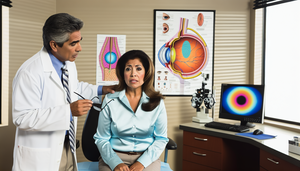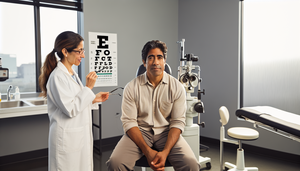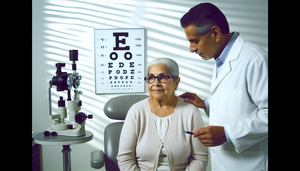
Fabry Disease: Diagnostic Keys and Differentiation of Neurological Processes in Alpha-Galactosidase Deficiency and Multiple Sclerosis
Discover how to differentiate Fabry disease from multiple sclerosis using essential diagnostic clues.
Read more
Systemic Amyloidosis: Evaluating Multisystem Symptoms and Differentiating from Multiple Myeloma
Discover how to differentiate systemic amyloidosis from multiple myeloma through multisystem evaluation and advanced techniques.
Read more
Tuberous Sclerosis: Identifying Facial Angiofibromas and Differentiating from Neurofibromatosis in Seizure Patients
Discover how to identify cutaneous signs of tuberous sclerosis and differentiate them from other phakomatoses.
Read more
Creutzfeldt-Jakob Disease: Recognizing Rapidly Progressive Dementia and Differentiating from Other Encephalopathies Using 14-3-3 Protein and EEG
Discover how to differentiate Creutzfeldt-Jakob disease from other treatable encephalopathies using key markers.
Read more
Shy-Drager Syndrome: Assessing Autonomic Dysfunction and Differential Diagnosis of Atypical Parkinsonism Using Magnetic Resonance Imaging
Discover how MRI and autonomic tests differentiate Shy-Drager syndrome from other parkinsonisms.
Read more
Early Detection of Guillain-Barré Syndrome: Differentiating from Chronic Polyradiculoneuropathy Using EMG and Lumbar Puncture
Early detection and differentiation between GBS and CIDP is crucial for optimal treatment.
Read more
Optic Neuritis: Key Symptoms, Risk Assessment for Multiple Sclerosis, and the Role of Evoked Potential Tests in Sudden Vision Loss and Eye Pain
Early identification of optic neuritis is crucial for assessing the risk of multiple sclerosis.
Read more
Multisystem Atrophy: Recognizing and Differentiating It from Other Parkinson Plus Syndromes Using MRI and Dysautonomia Insights
Discover how to differentiate multiple system atrophy from other Parkinson-plus syndromes using advanced techniques.
Read more
Frontotemporal Dementia: Early Diagnosis and Differentiation from Alzheimer's Disease through Behavioral Changes and Brain PET Imaging
Early differentiation between frontotemporal dementia and Alzheimer's enhances clinical management through neuroimaging and biomarkers.
Read more
Early Diagnosis of Pelizaeus-Merzbacher Disease: Differentiating from Other Leukodystrophies in Neonatal Hypotonia and Nystagmus with White Matter MRI
Early diagnosis of Pelizaeus-Merzbacher disease is crucial for differentiating it from other leukodystrophies and planning interventions.
Read more
Corticobasal Degeneration: Recognizing Asymmetric Rigidity and Apraxia for Differentiation from Atypical Parkinsonism Using Magnetic Resonance Imaging
Discover how to differentiate corticobasal degeneration from other atypical parkinsonisms through clinical evaluation and magnetic resonance imaging.
Read more
Early Diagnosis of Wilson's Disease: Differentiating from Chronic Hepatitis and Recognizing Neurological Symptoms
Early identification of Wilson's disease is crucial to prevent irreversible hepatic and neurological damage.
Read more
Peripheral Neuropathy: Clinical Evaluation and Differentiation of Diabetic Polyneuropathy through Sensitivity Testing and Conduction Velocity Analysis
Discover how to differentiate diabetic polyneuropathy through effective clinical evaluation and sensitivity testing.
Read more
Charcot-Marie-Tooth Disease: Early Diagnosis and Evaluation of Hereditary Peripheral Neuropathy through Electromyography and Differentiation of Ataxias
Early diagnosis of Charcot-Marie-Tooth disease enhances patient management and quality of life.
Read more
Myasthenia Gravis: Early Detection and Differentiation from Lambert-Eaton Syndrome Using Edrophonium Test and Anti-AChR Antibodies
Discover how to differentiate myasthenia gravis from Lambert-Eaton syndrome for accurate diagnosis.
Read more
Sydenham's Chorea: Diagnosis and Differentiation from Involuntary Movements and Huntington's Disease in Rheumatic Fever
Discover how to diagnose Sydenham's chorea and differentiate it from other causes of involuntary movements.
Read more
Retinitis Pigmentosa: Early Symptom Identification and Differentiation from Other Retinal Dystrophies
Early detection of retinitis pigmentosa is crucial for accurate differential diagnosis.
Read more
Age-Related Macular Degeneration: Early Diagnosis and Differentiation from Diabetic Retinopathy Using OCT and Fluorescein Angiography
Early detection and advanced imaging techniques are crucial for differentiating AMD from DR.
Read more
Rheumatoid Arthritis: Evaluating Initial Symptoms and Differentiating from Osteoarthritis with Rheumatoid Factor and Anti-CCP Antibodies
Discover how to differentiate rheumatoid arthritis from osteoarthritis through symptoms, serological markers, and imaging.
Read more
Osteoarthritis: Diagnostic Criteria and Differentiation from Rheumatoid Arthritis in Joint Pain Evaluation
Discover how to differentiate osteoarthritis from rheumatoid arthritis for more effective treatment.
Read more